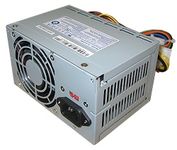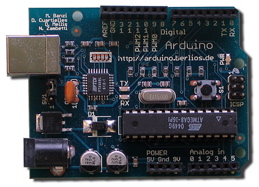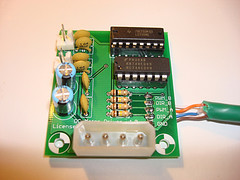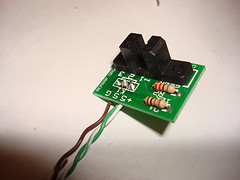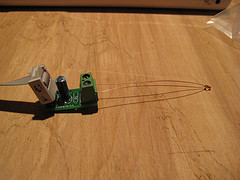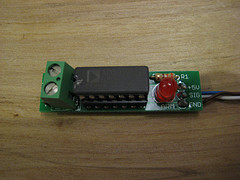Generation 2 Electronics
Contents
Arduino and Sanguino Based Electronics
Overview
Once you start putting electricity into your RepRap - even at just 12 volts - you have to take basic, common sense precautions to avoid fires. Just in case these fail, test your workshop smoke detector. Got no smoke detector? Get one!
Power Supply
The RepRap machine needs a regulated power supply giving at least 8 amps at 12 volts. The easiest way to do this is to convert a normal PC power supply into a RepRap power supply. Its simple, cheap, and all the boards are designed to accept the standard Molex connectors that are common on ATX power supplies.
More info and setup instructions here.
Individual Boards
Parts List
<iframe width='500' height='300' frameborder='0' src='http://spreadsheets.google.com/pub?key=pmEMxYRcQzzATwbOb71BmGA&output=html&gid=30&single=true&widget=true'></iframe>
Arduino, Sanguino & Arduino Clones
Arduino is an open source project that has created an easy and powerful microcontroller board based on the Atmel ATmega168. It is the brain of the RepRap electronics. You can get a premade Arduino, you can buy and assemble a kit, or you can even make it from scratch yourself. They all look the same to the rest of the electronics or to your computer. You will need an Arduino Nano, Diecimila, or Duemilanove or the latest equivalent.
Alternatively, you can use the Sanguino. Sanguino is an Arduino-compatible board based on the ATmega644P that was developed as a spinoff of the RepRap project by Zach Smith. It has four times the flash memory, four times the RAM, and many more pins than the Arduino. You can drive a RepRap with a standard Sanguino, but there will also soon be a special Sanguino RepRap Motherboard that makes the connections easier, has an SD card slot, and all sorts of other goodies.
A standard Darwin RepRap will run happily off an Arduino, but if you want expandability and upwards-compatibility for the future, go for the Sanguino.
Stepper Motor Driver v1.2
<div class="thumb tright"></div>Each stepper driver board drives one of the stepper motors. You need three of these boards for a fully functioning RepRap. Each board controls the position of one axis. Together, they position the print head anywhere in the 3 dimensional build area.
More info and build instructions here.
DC Motor Driver v1.1
<div class="thumb tright"></div>This board is capable of controlling two low current DC Motors in both forward and reverse. It has a speed/direction interface and is easy to control.
More info and build instructions here.
PWM Driver v1.1
<div class="thumb tright"></div>This board is capable of driving medium DC loads with TIP120 power transistors. It has a PWM interface and is also easy to control.
More info and build instructions here.
Opto Endstop v2.1
<div class="thumb tright"></div>All of a RepRap's axes all need a datum (also known as home position or end-stop) to reference their movements. At the start of each build each axis needs to back up until the datum point is reached. We use one opto-switch for each axis to define its position. This page tells you how to wire one up.
More info and build instructions here.
Temperature Sensor v1.1
<div class="thumb tright"></div>This sensor allows you to read a thermistor as an analog value. It is a very small and simple helper board.
More info and build instructions here.
Optional Boards
These boards are not required, but can be used to improve your machine or do different things.
Thermocouple Sensor v1.0
<div class="thumb tright"></div>The thermocouple sensor is a different type of temperature sensor board. Unlike the thermistor based temperature sensor which can only really handle temperatures up to 300C, the thermocouple sensor can handle temperatures up to and over 1000C. It uses a thermocouple for temperature measurement, and it is much easier to read values from (as well as being a bit more accurate over a wider range.
Unfortunately, it is also more expensive (by about $25)
More info and build instructions here.
Arduino breakout shield
This is a board that allows you to make screw-tab connections to the Arduino: less fiddly than the standard connections. See details here.
Wire It Up
Now that all the boards are created, you'll need to wire it all up. One of the main advantages of the Arduino/Sanguino based system is that it is highly configurable. Each board can be wired to the microcontroller in a number of ways. The Arduino can use the SNAP communications protocol or G Codes. SNAP is compatible with the older PIC RepRap control system. G Codes are the newer and more versatile way of controlling the machine. The Sanguino just uses G Codes.
Wiring up with an Arduino
See the Arduino RepRap 1_0 page for details of how to wire up and program your RepRap using an Arduino.
Wiring up with a Sanguino
See the Sanguino RepRap 1_0 page for details of how to wire up and program your RepRap using a Sanguino.
